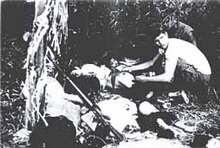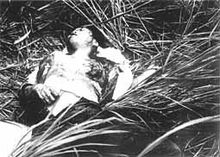Phong Nhị and Phong Nhất massacre: Difference between revisions
Viet Congs we also believed to carried out this attack |
Added Contexts and Further Details |
||
| Line 23: | Line 23: | ||
==Report== |
==Report== |
||
On 16 April 1968 the [[III Marine Expeditionary Force#Vietnam War|III MAF]] reported on the incident to [[Military Assistance Command, Vietnam]] (MACV). On 29 April, MACV sent the report to the ROK Vietnam Expeditionary Forces Commanding Officer [[Lieutenant general]] [[Chae Myung-shin]] ([[:ko:채명신|ko]]). On 4 June 1968, General Chae advised MACV that he had investigated the incident and concluded that the massacre had been perpetrated by [[Viet Cong]] forces disguised in Korean-style camouflage uniforms in order to discredit the Korean forces.<ref name=VV>{{cite web|url=http://vietnamvoices.org/wp-content/uploads/2015/10/US-Army-IG_ROK-Marines_Report_1969.pdf |format=PDF |title=Alleged Atrocity Committed by ROK Marines |date=1969-12-23 |website=Vietnamvoices.org |accessdate=2017-02-28}}</ref> Chae testified that there were numerous cases in which the Viet Cong utilized the duckhunter pattern used by the ROK Marines to commit misdeeds in order to incite unpopular opinion on ROK troops in the area and supported his claim with the testimonies of the District Chief of Dien Han District and an ARVN Sergeant.<ref name=VV/> |
On 16 April 1968 the [[III Marine Expeditionary Force#Vietnam War|III MAF]] reported on the incident to [[Military Assistance Command, Vietnam]] (MACV). On 29 April, MACV sent the report to the ROK Vietnam Expeditionary Forces Commanding Officer [[Lieutenant general]] [[Chae Myung-shin]] ([[:ko:채명신|ko]]). On 4 June 1968, General Chae advised MACV that he had investigated the incident and concluded that the massacre had been perpetrated by [[Viet Cong]] forces disguised in Korean-style camouflage uniforms in order to discredit the Korean forces.<ref name=VV>{{cite web|url=http://vietnamvoices.org/wp-content/uploads/2015/10/US-Army-IG_ROK-Marines_Report_1969.pdf |format=PDF |title=Alleged Atrocity Committed by ROK Marines |date=1969-12-23 |website=Vietnamvoices.org |accessdate=2017-02-28}}</ref> Chae testified that there were numerous cases in which the Viet Cong utilized the duckhunter pattern used by the ROK Marines to commit misdeeds in order to incite unpopular opinion on ROK troops in the area and supported his claim with the testimonies of the District Chief of Dien Han District and an ARVN Sergeant.<ref name=VV/> This is despite contradictory testimony by survivors of these massacres, interviewed by US Army Personnel at Da Nang hospital as well as US armed forces personnel whom rescued the civilians<ref>http://vietnamvoices.org/wp-content/uploads/2015/10/US-Army-IG_ROK-Marines_Report_1969.pdf</ref>. |
||
On 11 November 2000, General Chae conceded that [[Chief of Staff of the United States Army]] General [[William Westmoreland]] demanded the investigation several times.<ref name=hani001115c/> The ROK Command that the two villages were not in the route of the ROK Marines who patrolled the area and claimed the possibility of Viet Cong who wore the ROK Marine uniforms.<ref name=hani001115c>{{cite news|url=http://h21.hani.co.kr/section-021003000/2000/021003000200011150334008.html|script-title=ko:"한국군도 많이 당했다" 채명신 전 주월한국군총사령관 인터뷰… 남베트남군 사령관 만나 사과한 적도|author=Kim Chang-seok|newspaper=[[Hankyoreh]]|date=15 November 2000|accessdate=28 January 2011|language=ko}}</ref> |
On 11 November 2000, General Chae conceded that [[Chief of Staff of the United States Army]] General [[William Westmoreland]] demanded the investigation several times.<ref name=hani001115c/> The ROK Command that the two villages were not in the route of the ROK Marines who patrolled the area and claimed the possibility of Viet Cong who wore the ROK Marine uniforms.<ref name=hani001115c>{{cite news|url=http://h21.hani.co.kr/section-021003000/2000/021003000200011150334008.html|script-title=ko:"한국군도 많이 당했다" 채명신 전 주월한국군총사령관 인터뷰… 남베트남군 사령관 만나 사과한 적도|author=Kim Chang-seok|newspaper=[[Hankyoreh]]|date=15 November 2000|accessdate=28 January 2011|language=ko}}</ref> |
||
Revision as of 04:32, 19 May 2018
| Phong Nhị and Phong Nhất massacre | |
|---|---|
 U.S Marines recovered victims' bodies in Phong Nhi and Phong Nhat village on 12 February 1968 | |
| Location | Phong Nhi village, Điện Bàn District of Quảng Nam Province, South Vietnam |
| Date | 12 February 1968 |
| Target | Phong Nhi villagers |
Attack type | Massacre |
| Deaths | 69–79[1] |
| Perpetrators | Allegedly ROK Marines Allegedly Viet Cong in ROKMC Uniforms |

The Phong Nhị and Phong Nhất massacre[4][5] (Korean: 퐁니·퐁넛 양민학살 사건, Vietnamese: Thảm sát Phong Nhất và Phong Nhị) was a massacre allegedly conducted by the 2nd Marine Division of the South Korean Marines on 12 February 1968 of unarmed citizens in Phong Nhị and Phong Nhất village, Điện Bàn District of Quảng Nam Province in South Vietnam.[6][7]
Aftermath
After the massacre, U.S. Marines and Army of the Republic of Vietnam (ARVN) soldiers reached the village later that day; they treated and transported the surviving villagers to nearby hospitals.[2][3]
At the time the massacre occurred, the Phong Nhị villagers had had a close relationship with the U.S. Marines and the village men volunteered as ARVN soldiers.[8] On 25 February, the next massacre occurred in Hà Mỹ village. In 1969, one of the victims' families made a petition to the President of South Vietnam Parliament for compensation.[9]
Report
On 16 April 1968 the III MAF reported on the incident to Military Assistance Command, Vietnam (MACV). On 29 April, MACV sent the report to the ROK Vietnam Expeditionary Forces Commanding Officer Lieutenant general Chae Myung-shin (ko). On 4 June 1968, General Chae advised MACV that he had investigated the incident and concluded that the massacre had been perpetrated by Viet Cong forces disguised in Korean-style camouflage uniforms in order to discredit the Korean forces.[10] Chae testified that there were numerous cases in which the Viet Cong utilized the duckhunter pattern used by the ROK Marines to commit misdeeds in order to incite unpopular opinion on ROK troops in the area and supported his claim with the testimonies of the District Chief of Dien Han District and an ARVN Sergeant.[10] This is despite contradictory testimony by survivors of these massacres, interviewed by US Army Personnel at Da Nang hospital as well as US armed forces personnel whom rescued the civilians[11].
On 11 November 2000, General Chae conceded that Chief of Staff of the United States Army General William Westmoreland demanded the investigation several times.[12] The ROK Command that the two villages were not in the route of the ROK Marines who patrolled the area and claimed the possibility of Viet Cong who wore the ROK Marine uniforms.[12]
Statue
South Korean sculptors Un-sung Kim and Seo-kyung Kim designed a statue intended as an apology for this event.[13]
See also
References
- ^ Han Hong-gu, Sungkonghoe University professor. 미국의 관심은 ‘학살은폐 책임’ 최초공개된 미국 비밀보고서의 의미… 정부는 참전군인의 명예를 위해서 진상조사에 나서라. Hankyoreh (in Korean). Retrieved 29 January 2011.
- ^ a b c d Go Gyeong-tae (24 January 2001). 특집 "그날의 주검을 어찌 잊으랴" 베트남전 종전 26돌, 퐁니·퐁넛촌의 참화를 전하는 사진을 들고 현장에 가다. Hankyoreh (in Korean). Retrieved 27 January 2011.
- ^ a b 여기 한 충격적인 보고서가 있다 미국이 기록한 한국군의 베트남 학살 보고서 발견. OhmyNews (in Korean). Archived from the original on 6 March 2012. Retrieved 27 January 2011.
{{cite news}}: Unknown parameter|deadurl=ignored (|url-status=suggested) (help) - ^ Kwon, Heonik. After the massacre: commemoration and consolation in Ha My and My Lai. University of California Press. p. 47. ISBN 978-0-520-24797-0.
- ^ Kim Chang-seok (15 November 2000). 편견인가, 꿰뚫어 본 것인가 미군 정치고문 제임스 맥의 보고서 "쿠앙남성 주둔 한국군은 무능·부패·잔혹". Hankyoreh (in Korean). Retrieved 27 January 2011.
- ^ "The Australian Army and the Vietnam War 1962-1972 The making of tigers: south Korea's experience in the Vietnam War" (PDF). Australian Army. Archived from the original (PDF) on 21 March 2011. Retrieved 27 January 2011.
{{cite web}}: Unknown parameter|deadurl=ignored (|url-status=suggested) (help) - ^ Go Gyeong-tae. 잠자던 진실, 30년만에 깨어나다 "한국군은 베트남에서 무엇을 했는가"… 미국 국립문서보관소 비밀해제 보고서·사진 최초공개. Hankyoreh (in Korean). Retrieved 27 January 2011.
- ^ Kwon, Heonik. After the massacre: commemoration and consolation in Ha My and My Lai. University of California Press. p. 32. ISBN 978-0-520-24797-0.
- ^ Go Gyeong-tae (23 November 2000). "끝없이 벗겨지는 '제2의 밀라이'". Hankyoreh. Retrieved 25 July 2011.
- ^ a b "Alleged Atrocity Committed by ROK Marines" (PDF). Vietnamvoices.org. 1969-12-23. Retrieved 2017-02-28.
- ^ http://vietnamvoices.org/wp-content/uploads/2015/10/US-Army-IG_ROK-Marines_Report_1969.pdf
- ^ a b Kim Chang-seok (15 November 2000). "한국군도 많이 당했다" 채명신 전 주월한국군총사령관 인터뷰… 남베트남군 사령관 만나 사과한 적도. Hankyoreh (in Korean). Retrieved 28 January 2011.
- ^ "Sculptor to make symbol of Vietnam massacres". koreatimes. 2017-06-21. Retrieved 2017-06-22.
Further reading
- Armstrong, Charles (2001). Critical Asian Studies: America's Korea, Korea's Vietnam. Vol. 33. Routledge.
- Kwon, Heonik. After the massacre: commemoration and consolation in Ha My and My Lai. University of California Press. ISBN 978-0-520-24797-0.
External links
- Massacres in Vietnam
- Military history of South Korea during the Vietnam War
- Quang Nam Province
- Vietnam War crimes
- Massacres committed by South Korea
- South Korean war crimes
- War crimes in Vietnam
- Military scandals
- Mass murder in 1968
- 1968 in Vietnam
- United States Marine Corps in the Vietnam War
- February 1968 events
